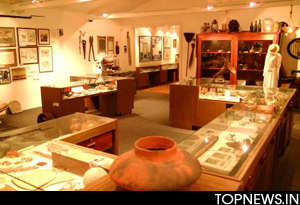Museums aplenty in Netherlands
 Amsterdam - Small museums enjoy cult status in the Netherlands exhibiting items as varied as tulips, handbags, trees and dredges.
Amsterdam - Small museums enjoy cult status in the Netherlands exhibiting items as varied as tulips, handbags, trees and dredges.
The latter in the town of Sliedrecht, near Rotterdam, is the National Museum of Dredging (Nationaal Baggermuseum).
"And here we have our Rembrandt," said curator Hans Wijn as he pointed to a glass display case with a model of the dredge Pharaon. Used for many years in the Suez Canal, it was sunk during the Suez Crisis in 1956.
The museum's collection of 130 model dredges is unique, giving visitors insight into how these floating giants are used on oceans, rivers and canals to clear shipping channels and make harbours more accessible. The collection expands every year.
As for tulips, the edge of Amsterdam's Jordaan district has been home to the Amsterdam Tulip Museum since 2004. Its director, Sjoerd van Eeden, enlightens tourists from all over the world about such things as the origin of tulips, namely the mountains of Central Asia. The small collection traces the centuries-old history of floriculture.
Just a few kilometres away, in the Prinsengracht canal opposite house number 296, is a footbridge leading to the Houseboat Museum
(Woonbootsmuseum). The only museum of its kind in the world, it is housed on a barge called Hendrika Maria - converted into a houseboat - that used to haul gravel, sand and coal.
Be it boats, flowers or dredges, the Dutch seem to have a museum for everything: bicycles, ice skates, hash, sex and even handbags.
"My mother collected handbags for 30 years," said Sigrid A. Ivo, director of the Museum of Bags and Purses (Tassenmuseum Hendrikje) on Amsterdam's Herengracht. Hendrikje Ivo, born in 1936, accumulated some 4,000 bags and accessories, 1,500 of which are on display.
"Handbags are far more than women's silent companions," said the younger Ivo, adding, "Handbags are a reflection of fashion epochs and trends."
The Tree Nursery Museum (Boomkwekerijmuseum) in Boskoop is dedicated to ornamental woody plants. The region between Gouda and Leiden has been noted for its "boomkwekerijen" or tree nurseries, since the Middle Ages.
"So the idea of showing the history of our tree nurseries and woody plants suggested itself," said Willem Sanders and Piet Stolk, members of the foundation that operates the museum.
The garden lovers created the museum by reconstructing the home of a tree-nursery owner from the 1870s. Among the fruit trees in the garden is the "Schone van Boskoop" (Boskoop Beauty). "This apple variety was discovered here in 1856," Sanders noted with pride.
Visitors to the Netherlands' first museum dedicated to the former East Germany, established in Monnickendam by Thea Grijsen and Professor Friso de Zeeuw, discover other things: medals, badges, pennants, flags, phonograph records, travel documents, books and ballots.
The private collection, housed in a car garage, has grown to 3,000 exhibits.
"In 1989, right after the fall of the Berlin Wall, I bought the first exhibits - a medal and a cap - at a second-hand stand," de Zeeuw recalled. Ever since, he and Grijsen have been occupied by the lives of citizens of the German Democratic Republic.
Internet: www.holland.com, www.tassenmuseum.nl, www.amsterdamtulipmuseum.com, www.boomkwekerijmuseum.nl, www.baggermuseum.nl, www.houseboatmuseum.nl, www.ddr-museum.nl. (dpa)